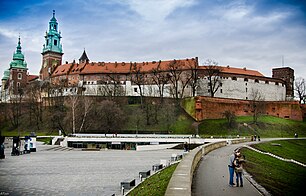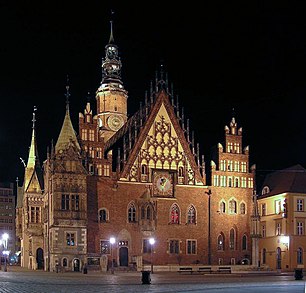| Revision as of 21:32, 27 October 2013 edit87.99.45.74 (talk) →Natural environment← Previous edit | Revision as of 21:36, 27 October 2013 edit undoWKS Śląsk Wrocław (talk | contribs)267 editsNo edit summaryNext edit → | ||
| Line 28: | Line 28: | ||
| ]]] | ]]] | ||
| ]]] | ]]] | ||
| ] in ]]] | ] in ]]] | ||
| ] is a part of the global tourism market with constantly increasing number of visitors. '''Tourism in Poland''' contributes to the country's overall economy. The most popular cities are ], ], ], ], ], ], ]. The best recreational destinations include Poland's ] coast, ], ] (the highest mountain range of ]), ] and ]. ]'s main tourist offers consist of sightseeing within cities and out-of-town ], business trips, qualified tourism, ], mountain ] (]king) and ] among others. Poland is the 17th most visited country in the world by foreign tourists, as ranked by World Tourism Organization (]) in 2012<ref></ref>. | ] is a part of the global tourism market with constantly increasing number of visitors. '''Tourism in Poland''' contributes to the country's overall economy. The most popular cities are ], ], ], ], ], ], ]. The best recreational destinations include Poland's ] coast, ], ] (the highest mountain range of ]), ] and ]. ]'s main tourist offers consist of sightseeing within cities and out-of-town ], business trips, qualified tourism, ], mountain ] (]king) and ] among others. Poland is the 17th most visited country in the world by foreign tourists, as ranked by World Tourism Organization (]) in 2012<ref></ref>. | ||
Revision as of 21:36, 27 October 2013
Poland's most popular destinations Dolina Gąsienicowa in the High Tatras
Dolina Gąsienicowa in the High Tatras European bison at Białowieża Forest UNESCO World Heritage Site and Biosphere Reserve
European bison at Białowieża Forest UNESCO World Heritage Site and Biosphere Reserve Royal palace at Wawel
Royal palace at Wawel Town Hall in Wrocław in the Market Square
Town Hall in Wrocław in the Market Square Project Riese, Owl Mountains in the Sudetes
Project Riese, Owl Mountains in the Sudetes Auschwitz concentration camp
Auschwitz concentration camp Malbork Castle in Malbork, northern Poland
Malbork Castle in Malbork, northern Poland Dunajec River Gorge, UNESCO's Tentative List of World Heritage Sites
Dunajec River Gorge, UNESCO's Tentative List of World Heritage Sites Jasna Góra Monastery Basilica, most popular with religious tourism of Poland
Jasna Góra Monastery Basilica, most popular with religious tourism of Poland Augustów Canal kayaking in Augustów
Augustów Canal kayaking in Augustów




Poland is a part of the global tourism market with constantly increasing number of visitors. Tourism in Poland contributes to the country's overall economy. The most popular cities are Kraków, Wrocław, Gdańsk, Warsaw, Poznań, Lublin, Toruń. The best recreational destinations include Poland's Baltic Sea coast, Masurian Lake District, Tatra Mountains (the highest mountain range of Carpathians), Sudetes and Białowieża Forest. Poland's main tourist offers consist of sightseeing within cities and out-of-town historical monuments, business trips, qualified tourism, agrotourism, mountain hiking (trekking) and climbing among others. Poland is the 17th most visited country in the world by foreign tourists, as ranked by World Tourism Organization (UNWTO) in 2012.
History
The first Polish tourists were pilgrims traveling to shrines both within Poland and abroad. The development of commercial tourism began in the 19th century. The most popular regions were mountains, especially the Tatra Mountains, explored for example by Tytus Chałubiński. In 1873 the Polish Tatra Society and in 1909 the Polish Sightseeing Society were established to organize and develop tourism. The 19th century was also the time of the rapid appearance of spa resorts, mostly in Sudetes, Beskids and along the Baltic Sea coast, with some of them associated, since 1910, with the Polish Balneology Association. After Poland regained independence in 1918, Polish tourism boomed, and was encouraged by the government. The first professional Polish tour operator, Orbis, was founded in Lwów in 1923, followed in 1937 by Gromada tourist organization and tour operator.
After World War II all tourist organizations were nationalized by the new communist government. The Polish Tatra Society and Polish Sightseeing Society were combined into Polish Tourism-Sightseeing Society (PTTK) and most of the tourist infrastructure was handed over to the newly-created Workers Vacations Fund (FWP). Tourism was limited to the Comecon countries. This was the era of governmentally-founded tourism, characterised by mass but low-standard tourism. A typical sight was a holiday campground with small bungalows managed by one of the state-owned companies. Holidays for children and teenagers were organized by Juventur. After the fall of communism much of the infrastructure was privatized, although many company-owned resorts were downgraded because of their unprofitability. The early 1990s saw the foundation of many new tour operators. Some of them prevailed and strengthened their position on the market, being able to compete with multinational tour operators like TUI, or Neckermann und Reisen with branches in Poland.
Tourist attractions of Poland
Poland, especially after 1989 and joining of the European Union in 2004, became a place frequently visited by tourists. Most tourist attractions in Poland are connected with natural environment, historic sites and cultural events. They draw millions of tourists every year from all around the world. According to Tourist Institute's data, Poland was visited by 15.7 million tourists in 2006, and by 15 million tourists in 2007, out of the total number of 66.2 million foreign visitors. In 2012, Poland was visited by 13.5 million foreign tourists (those who came during Euro 2012, but did not stay overnight, were not included in official statistics).
Natural environment
See also: List of national parks of PolandPoland has a diversified natural environment, which is relatively unaffected by human development. Poland is the fourth most forested country in Europe. Forests in Poland are freely available. The largest forest complex in Poland is Lower Silesian Wilderness. Visitors are attracted by mountains, sea-coast, and the forests and lake reserves. Among the most popular destinations are: Tatra Mountains, in which is the highest peak of Polish (Rysy) and the famous Orla Perć; Karkonosze, Table Mountains, Białowieża Forest, Bieszczady, Dunajec River Gorge in Pieniny, Pojezierze Mazurskie, Kampinos National Park and many others.
World War II
In Poland, there are many places connected with the history of World War II, for example: German nazi concentration camps Auschwitz concentration camp, Belzec extermination camp, Gross-Rosen concentration camp, Chełmno extermination camp, Majdanek concentration camp, Kraków-Płaszów concentration camp, Sobibor extermination camp, Stalag Luft III, Stutthof concentration camp, Treblinka extermination camp, Warsaw concentration camp; Project Riese, German War Cemetery and Park Peace in the Nadolice Wielkie, and many other places during the war germany office organized its various institutions.
Tourist destinations by city
- Atrakcje turystyczne w Warszawie
- The Royal Road of Kraków
- The Royal-Imperial Route in Poznań
- Jewish Heritage Trail in Bialystok
Historic buildings and places
- Team of the historic city center of Wroclaw: Ostrów Tumski, Wrocław Old Town with Market Square, Wrocław New Town
- Centennial Hall in Wrocław and Wrocław Fountain
- Mount Ślęża
- Wooden Churches of Peace in Jawor and Świdnica
- Kłodzko Fortress
- Project Riese
- Lubiąż Abbey
- Grüssau Abbey
- Vang stave church
- Gniezno Cathedral
- Kraków (Cracow) Old Town
- Auschwitz-Birkenau State Museum
- 13th century Salt mine in Wieliczka
- Wooden Churches of Southern Little Poland
- Jasna Góra Monastery in Częstochowa
- Sanctuary in Kalwaria Zebrzydowska
- Medieval Town of Toruń in Toruń
- Gdańsk Old Town in Gdańsk
- Zamość Old Town in Zamość
- Augustów Canal
- Muskau Park
Castles
See also: List of castles in Poland Main article: Trail of the Eagles' Nests- Wawel Royal Castle
- Malbork Castle
- Książ Castle
- Chojnik
- Czocha Castle
- Grodno Castle pl:Zamek Grodno
- Grodziec castle
- Niesytno Castle
- Gorzanów Castle
- Gola Dzierżoniowska Castle
- Kliczków Castle
- Krzyżtopór
- Ogrodzieniec
- Dunajec river castles
Popular villages
- Chochołów, Lesser Poland Voivodeship
- Bączal (near Biecz known as little Kraków)
- Srebrna Góra, Lower Silesian Voivodeship
- Henryków, Lower Silesian Voivodeship
- Oleśnica Mała
- Legnickie Pole, site of the Battle of Legnica
- Gogołów (near Świdnica, World Heritage Churches of Peace)
- Wambierzyce, pilgrimage site to statue of Our Lady
Cultural events
Further information: Culture of Poland- Festival of good beer in Wrocław
- New Horizons Film Festival
- Wratislavia Cantans
- International Frederick Chopin Piano Competition
- Warsaw Autumn Music Festival
- Jazz Jamboree
- Sopot International Song Festival
- Transatlantyk – Poznań International Film and Music Festival
- Events in Kraków (arranged by month)
- Belarusian Song and Poetry Festival in Białystok
- Open'er Festival in Gdynia
- Camerimage Film Festival in Bydgoszcz
- National Festival of Polish Song in Opole
Tourist resorts
There are dozens of sea resorts on the coast of Baltic Sea like Wolin Island, located close to the German border and the coast of Pomerania. In southern Poland there are resorts for skiing and hiking in the Karkonosze mountains, which is part of the Sudetes mountain range. Karkonosze includes the touristical centres of Karpacz and Szklarska Poręba. Other famous resorts for skiing and hiking include in Carpathian Mountains: Zakopane in the Tatra mountains; Szczyrk, Krynica-Zdrój, Ustroń, Wisła in Beskides or Szczawnica and Krościenko in Pieniny mountains.
Transportation in Poland
Main article: Transportation in PolandSince the fall of communism transportation in Poland has been improving. There is acceptable tourist infrastructure, especially in larger cities and in major tourist resorts. Most major Polish cities have airports with connecting services with the Frederic Chopin Airport in Warsaw. Intercity travel includes the PKP's Intercity train, Przewozy Regionalne, local trains (Koleje Dolnośląskie, Szybka Kolej Miejska (Tricity), Koleje Mazowieckie, and other) and PKS's overland bus. There are also coach connections to other countries provided by various companies.
See also
- Polish Tourist and Sightseeing Society (Template:Lang-pl)
- Mountain Volunteer Search and Rescue (Template:Lang-pl)
- Tatra Volunteer Search and Rescue (Template:Lang-pl)
- List of spa towns in Poland
- Tourism
References
- UNWTO Tourism Highlights
- Information about tourism in Poland (in Polish). Source: Instytut Turystyki, 2008.
- GUS (2008). "Przyjazdy do Polski (Foreign visits to Poland)". Statistics (in Polish). Instytut Turystyki. Retrieved December 31, 2012.
- Katarzyna Sobierajska, Ministry of Tourism (2012). "Pierwsze efekty Euro 2012. Resort turystyki przewiduje wzrost liczby turystów w 2013 r. nawet o pół miliona". Live interview (in Polish). Agencja Informacyjna Newseria. Retrieved December 31, 2012.
{{cite web}}: Italic or bold markup not allowed in:|publisher=(help)
=
Further reading
- Kaszynski, Tadeusz, Through Europe to Poland by Car, 1st and rev. ed., New York, 1968
External links
| Poland articles | |||||||||
|---|---|---|---|---|---|---|---|---|---|
| History |
| ||||||||
| Geography | |||||||||
| Politics | |||||||||
| Economy | |||||||||
| Society |
| ||||||||
| Tourism in Europe | |
|---|---|
| Sovereign states |
|
| States with limited recognition | |
| Dependencies and other entities | |